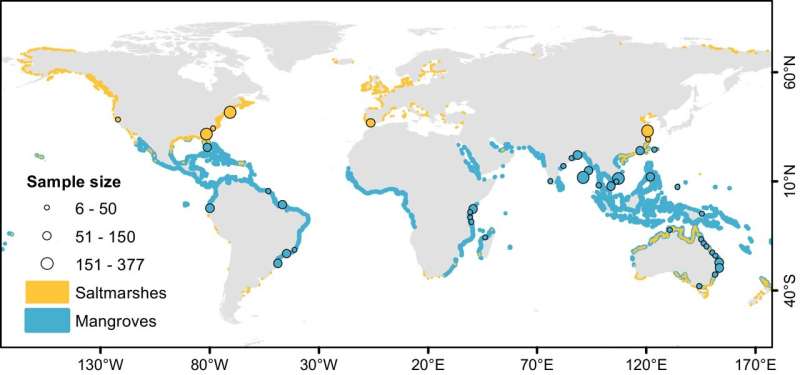Mangroves are major carbon sinks. New research shows that the climate mitigation effect is even better than previously thought. Credit: Luke Jeffrey
Mangroves and saltmarshes sequester large amounts of carbon, mitigating the greenhouse effect. New research from the University of Gothenburg shows that these environments are perhaps twice as effective as previously thought.
Natural habitats flooded by the tide form ecosystems that captures large amounts of carbon, which can help to mitigate climate change. Carbon dioxide is stored in the biomass and in the muddy soils. Therefore, several governments have launched blue carbon market initiatives to encourage landowners to restore and preserve mangrove and saltmarsh ecosystems, similar to the rainforest.
Large flow of bicarbonate
New research from the University of Gothenburg shows that the climate mitigation effect is even better than previously thought. The paper is published in the journal Nature Communications.
"We have uncovered additional stored carbon in mangrove forests and salt marshes. Our new findings show that much of the carbon is exported to the ocean bound as bicarbonate as the tide recedes and remains dissolved in the ocean for thousands of years. Bicarbonate stabilizes the pH and can reduce ocean acidification. This contribution has previously been overlooked," says Gloria Reithmaier, a researcher in marine chemistry at the University of Gothenburg.
Bicarbonate is harmless and is used in baking powder, among other things. In the oceans, carbonate and bicarbonate are used to build shells and coral skeletons.
Location of mangroves and saltmarshes with alkalinity (TA) and dissolved inorganic carbon (DIC) observations. Credit: Nature Communications (2023). DOI: 10.1038/s41467-023-44037-w
Measured all over the world
Reithmaier and her colleagues enlisted the help of scientists from 12 different countries to analyze intertidal carbon transport in 45 mangrove swamps and 16 salt marshes around the world. When they accounted for bicarbonate export from the ecosystems to the ocean, the size of the carbon trap in these ecosystems doubled.
"Our results showed that bicarbonate exports were equal to, or even surpassed, the amount of carbon stored in the soil. Therefore, previous estimates of these blue carbon sources have underestimated the potential of mangroves and saltmarshes to mitigate climate change," says Gloria Reithmaier.
"Our results show that blue carbon ecosystems are more effective in mitigating climate change than previously thought. It is now even more important to protect and restore mangrove and salt marsh ecosystems."
More information: Gloria M. S. Reithmaier et al, Carbonate chemistry and carbon sequestration driven by inorganic carbon outwelling from mangroves and saltmarshes, Nature Communications (2023). DOI: 10.1038/s41467-023-44037-w
Journal information: Nature Communications
Provided by University of Gothenburg
























